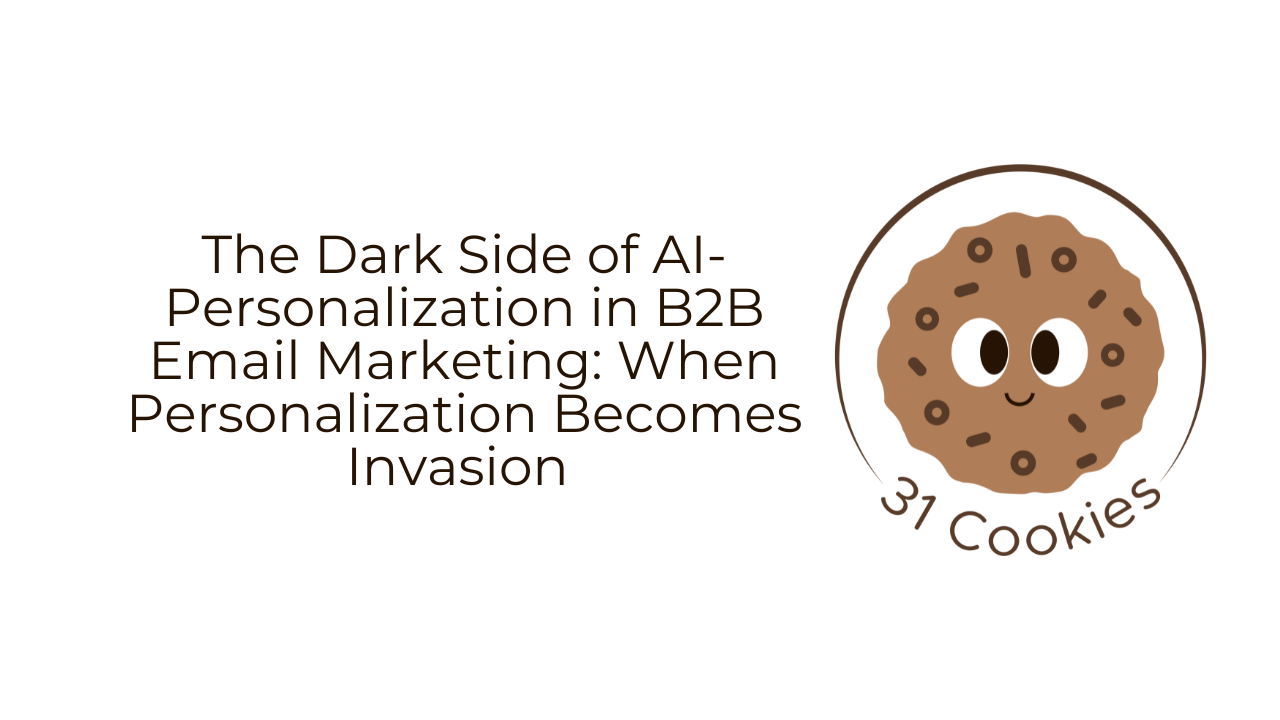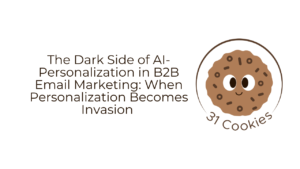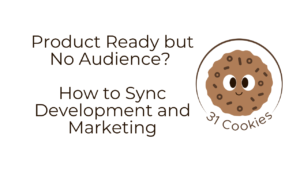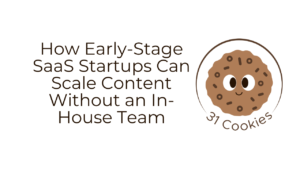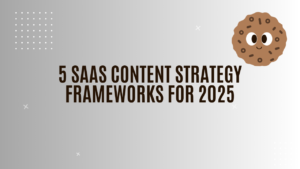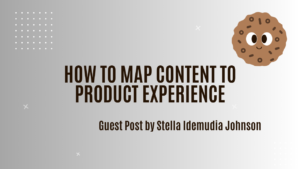For B2B marketers, the line between ‘helpful’ and ‘creepy’ is thinner than ever.
AI personalization can be powerful. But when it feels like surveillance, you risk losing subscribers. You could also face fines of up to 4% of global revenue—tens of millions under GDPR.

There’s no doubt AI-powered personalization in B2B email marketing delivers on its hype. It lifts engagement, boosts conversions, and makes nurture campaigns smarter. But push it too far, and it risks eroding trust, introducing bias, and damaging brand reputation.
This piece dives into those trade-offs. I’ve curated it specifically for B2B marketers using AI in email marketing, since research shows 71% rely on email newsletters and 63% on email marketing overall. I’ll highlight the pitfalls of AI-powered personalization in email marketing, real examples from B2B marketers, and steps to mitigate them.
Why AI-Powered Email Personalization Is Every Marketer’s Dream
Traditional email marketing was a volume game. Marketers sent everything from welcome emails to SaaS sign-up emails, segmented lists by industry or job title, wrote a few “personalized” templates, and hit send.
Marketers had it rough—manual segmentation that missed real intent, surface-level personalization that didn’t click, and timing based on guesswork.
For buyers, it was no better: inboxes flooded with irrelevant promos that all looked the same.
How HubSpot used AI-driven personalization to target leads
HubSpot ran an experiment with leads who’d downloaded influencer marketing content but were really interested in planning and seasonal prep. Instead of sending generic material, they offered a content-strategy course with messaging like, “Turn every sip into a story that captivates and converts.”
That aligned with what the lead was actually working on, which resulted in:
- 82% increase in conversion rate
- 30% boost in open rates
- 50% increase in click-through rates
The “Relatable Right Now” factor
It’s not just the big players. A B2B marketer on Reddit shares how an AI tool cut hours of research and crafted messages that resonate based on what matters right now.
That “right now” factor is where AI-driven personalization outshines traditional marketing tactics as it turns nurture campaigns into contextual, timely conversations.
Say a lead signs up for a marketing analytics tool and opens the welcome email. Instead of waiting a week for a generic nurture, automation kicks in right away and triggers the next touch. If their open rate tops 42% and CTR beats the benchmark, the system flags them as a warm lead.
Without AI, marketing managers have to track engagement by hand, compare benchmarks, and build custom workflows. But that approach doesn’t scale. AI does the heavy lifting by ensuring every prospect receives the right message at the right time, meeting them at whatever stage of the funnel they’re in.
Note: Predictive scoring even suggests a specific percentage of higher likelihood of activation if nudged within 24–48 hours.
Not All That Glitters is Gold – The Risks of AI-Powered Personalization
AI-powered personalization fixes many marketer headaches, but it comes with risks.
- Over-Collecting Data Cannibalizes Consumer Trust
Relevance builds trust, surveillance destroys it.
Some managers go all out tracking every click, hover, and email open, collecting IPs, browsing history, and even off-site activity, often using tools that don’t handle opt-ins properly.
What began as helpful insights now flirts with GDPR and CCPA, putting familiar metrics like open rates and clicks under the microscope.
Chris Waker shares how their campaign backfired after seeing an initial spike.
“In one of our campaigns, over-personalized email subject lines that referenced very specific browsing behavior led to a 17 percent drop in open rates and multiple unsubscribe complaints. “
- Algorithmic Bias Excludes Potential Customers
If your data is biased, your personalization will be too.
If the prospect is warm, AI surfaces ads to “high-likelihood converters.” But if the model flags certain groups, like smaller startups, as less profitable, they never see the campaigns.
In trying to optimize for short-term wins, marketers can unintentionally shut out segments that could have been loyal, long-term customers.
- Inauthentic Personalization Feels Formulaic
Hyper-targeted emails like “Still comparing us after three visits to our pricing page?” may sound clever, but often backfire. Instead of feeling understood, prospects feel watched.
The bigger revenue killer is when AI churns out content so formulaic that it loses authenticity. Dwight Zahringer, Founder of a US-based digital marketing agency, shares how Gmail flagged one of their clients’ emails as promotional.
“One SaaS client saw Gmail flag their AI-generated subject lines as “promotional,” which cut deliverability by 60%. When they simplified personalization to focus on behavioral triggers, click-through rates jumped 40%.“
- Tailored Experiences Can Turn Templated
Automated nurture sequences may seem personal at first, but patterns show quickly. Prospects notice repetitive structures, overused first names, and identical CTAs.
As Mark Schaefer put it:
“Personalized is cut and paste. Personal is unique and custom.”
Use AI to automate messaging and to reveal insights for authentic, human-driven engagement.
- AI Non-Compliance Leads to Penalties
Even with AI and automation tools that claim built-in compliance, the responsibility to ensure lawful, ethical data use rests with the marketer.
A Telecom firm was penalized after it sent unsolicited advertisements without valid consent, didn’t provide proper unsubscribe options, and worked with partners who collected customer data improperly.
Globally, regulators have already fined companies for similar practices.
Note: Non-compliance with the Digital Personal Data Protection Act in India can lead to penalties as high as INR 250 crore (~USD 30 million) for violations such as data misuse or breaches.
Redefining Ethical AI in Email Marketing
If you use AI for all user touchpoints, it’s easy for users to lose interest and mark your emails as spam.
To strike a balance, take a user-centric approach. Focus on 2-3 meaningful touchpoints, capture explicit consent, stay transparent, and regularly audit compliance.
Continuously test campaigns, use feedback to iterate, and set clear guidelines for data use.
| A handy AI email personalization compliance checklist for marketers: ✅ Capture explicit consent → GDPR/CCPA-compliant signup forms, avoid pre-checked boxes ✅ Be transparent → Clearly state what you track (clicks, cookies, IPs) and why ✅ Use compliant tracking → Deploy cookie banners and only drop cookies after opt-in ✅ Stay relevant, not creepy → Personalize around interests, not exact browsing behavior ✅ Vet your tools and vendors → Ensure email automation tools include GDPR/CCPA compliance features ✅ Stay relevant → Avoid formulaic subject lines; test AI-generated content against human-written alternatives. ✅ Audit and train regularly → Run compliance checks and educate teams on data use ✅ Plan for escalation → Have a response plan in case AI missteps (e.g., creepy personalization or a data breach) |
The way forward for AI-powered personalization in marketing is a healthy collaboration between AI and humans.
AI is the ally, but humans must provide the training, judgment, and ethical compass.
Want content that feels human, builds trust, and keeps compliance covered? 31Cookies can help you find that balance.

